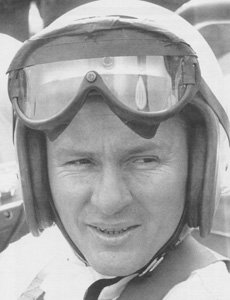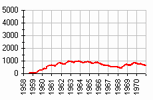Гонщики, M | |
McLaren, Bruce Курсивом отмечены гонщики, |
| Брюс МакЛаренMcLaren, Bruce |
 (c) 'Who is Who' by Steve Small, 2000 Родился: 30.08.1937 Окленд Умер: 02.06.1970 трасса Гудвуд, Сассекс, Англия Сезонов в Ф1: Лет в Ф1: 13 Гран При: Старты: 100* *не стартовал: 5 Победы: - подряд: 2 Подиумы: - подряд: 5 Поул-позиции: - подряд: Первый ряд: - подряд: 3 Быстрые круги: - подряд: Лучший финиш: Лучший старт: 2 Дубли: Хет-трики: Лидирование старт/финиш: Большие шлемы: Круги: - лидирования: 42 Километры: - лидирования: |
Год | Команда | Шасси |
Of all the many motor racing fatalities of the era, the death of Bruce McLaren was perhaps the most shocking. By general consensus the safest driver in the sport, his fatal accident while testing his Can-Am McLaren at Goodwood in 1970 was greeted at the time with utter disbelief.
Arriving in Europe virtually unknown, but with the endorsement of Jack Brabham, on a scholarship from the New Zealand Grand Prix Association in March 1958, McLaren's early career was sensational. In Formula 2 with a works Cooper, he took a class win and fifth overall in the German Grand Prix and, showing a maturity beyond his years, mixed it with seasoned competitors on unfamiliar tracks to such good effect that he finished runner-up in the Autocar F2 championship. Promoted to the F1 works team with Brabham in 1959, Bruce was completely unfazed in the top flight and at the end of the season became the youngest-ever GP winner (at 22) when he won the US GP at Sebring. The 1960 season opened with another triumph, this time in Argentina, but the rest of the year saw him content to understudy Brabham as he headed towards a second successive title. There is no doubt that Bruce learned much from his mentor, who moved on at the end of 1961 to build his own cars. Unfortunately, Cooper's fortunes now began to decline, although McLaren picked up a fortunate win at Monaco and also won the non-title Reims GP. During this period Bruce was happy to spend the winter months back home competing in the Tasman series which provided him with a number of wins. In 1964 he was forced to enter his own cars down-under and thus Bruce McLaren Motor Racing was born. That year also saw a great ambition fulfilled when he won the New Zealand GP at his eighth attempt. Tragedy struck with the death of Tim Mayer, whom Bruce had taken under his wing, but the young American's elder brother Teddy stayed on to become a pillar of the new team which slowly took shape over the next two seasons. Initially the programme centered on the Cooper Zerex Special sports car, later developments of which were to lead towards the team's successful Can-Am cars, which formed the basis of McLaren's emergence as a constructor. Meanwhile Bruce plugged away faithfully at Cooper to the end of the 1965 season, but his various freelance activities, which included racing for Ford in endurance events, had grown to such an extent that the final break was inevitable.
He introduced the white Formula 1 McLaren in 1966, but his season was hampered by the lack of a suitable engine, and the demands of a sports car programme with the McLaren Elva Oldsmobile which by this time was really taking off in North America. However, the highlight of the year for Bruce was winning the Le Mans 24 Hours for Ford with Chris Amon. The pace of expansion continued in 1967, when McLaren was totally involved in F1, now with BRM power. However, this was still an interim unit - indeed, Bruce was glad to race Dan Gurney's second Eagle for a spell after Ginther's sudden retirement rather than use his own machine. A Formula 2 version of the car appeared for the first time which Bruce drove when sports car and F1 commitments permitted. In addition, he shared the victorious Ford Mk II with Andretti at the Sebring 12 Hours, and also won rounds of the growing Can-Am series at Monterey and Riverside on his way to the title.
Clearly the task of heading the team and developing and driving the cars was becoming too much for Bruce to handle on his own, and he tempted Denny Hulme from Brabham for 1968 to take some of the weight off his shoulders. It was a move that showed his wisdom, for he was quite prepared to play second fiddle to the new World Champion, though when the mood took him McLaren the racer, for so long closeted, was allowed to re-emerge, as at Brands Hatch where he unleashed a stunning performance to win the Race of Champions in the bright-tangerine M7A. Onlookers that day were tempted to wonder just what reservoirs of talent lay untapped. Shortly afterwards he took his final Grand Prix win at Spa, but it was Hulme who led the team's title challenge for the rest of the season. However, it was the ever-consistent Bruce who enjoyed the uper hand in 1969, finishing third in the championship behind Stewart and Ickx. He also took the Can-Am title for the second time, dominating the series with six outright victories and three second places.
Though there were hints of impending retirement, Bruce carried on racing into 1970, with plans afoot to tackle Indianapolis after the success of the Can-Am cars. In due course a McLaren would win the Indy 500, but sadly the team's founder and inspiration was not around to see the success. He perished on a sunny June afternoon when a piece of bodywork flew from the car, sending it out of control. Poor Bruce was killed instantly when the car careered into a disused marshals' post.
Mention the name McLaren in the 1990s and most people will immediately think of the wonderful red and white cars which have established so many records. But Ron Dennis can surely testify that all those lucky enough to have either met the remarkable New Zealander or seen him in action will also never forget the man with the silver helmet in the tangerine car who began it all some three decades ago.
(c) 'Who is Who' by Steve Small, 2000
| © WildSoft, 1995-2020 |



